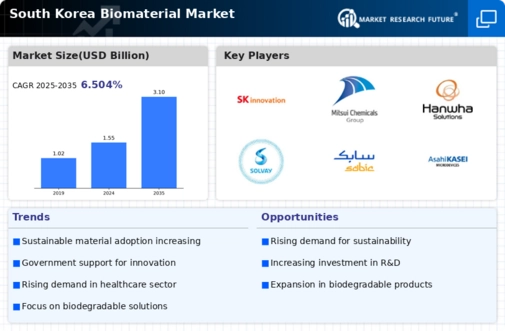The South Korea Biomaterial Market has recently gained significant traction due to the increasing focus on sustainability and the demand for eco-friendly alternatives to traditional materials. As the country invests in green technologies and renewable sources for production, the biomaterial sector has started to attract considerable attention from both manufacturers and consumers. This market encompasses a broad range of biobased products that are sourced from renewable materials. In addition to the rising awareness of environmental issues, government policies supporting the use of bioproducts have further stimulated growth in this sector.
As companies strive to enhance their product offerings and improve production methods, competition within the market has evolved, leading to innovations and collaborations that are shaping the industry's future.
In terms of market presence, SK Innovation stands out in the South Korea Biomaterial Market with its strong commitment to research and development. The company has leveraged its extensive experience in energy and materials to transition towards providing sustainable biomaterials. SK Innovation focuses on high-quality biopolymers and has made substantial investments to enhance its production capabilities. The company's existing infrastructure, combined with its robust supply chain, enables it to deliver products efficiently while maintaining high sustainability standards.
The emphasis on innovation and the ability to adapt to changing consumer preferences strengthens SK Innovation's competitive edge, allowing it to maintain a leading position in the South Korean biomaterial space.
Mitsui Chemicals has also established a solid foothold within the South Korea Biomaterial Market, showcasing its commitment to producing innovative bioproducts and developing sustainable solutions across various sectors. The company offers a diverse array of key products, including biodegradable resins and environmentally friendly additives. Mitsui Chemicals has been proactive in expanding its market presence through strategic partnerships and collaborations with both local and international entities, helping to facilitate the adoption of biomaterials in multiple industries. The company's focus on sustainability has been further bolstered by various mergers and acquisitions aimed at acquiring technologies that enhance its biomaterial offerings.
Mitsui Chemicals leverages its advanced research initiatives which are crucial in positioning themselves as a leader in bioproduct innovation tailored to meet local market demands in South Korea, reinforcing their strengths in a rapidly evolving sector.




















